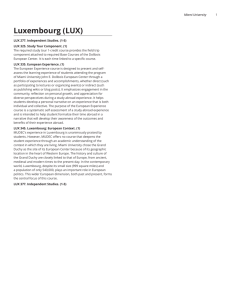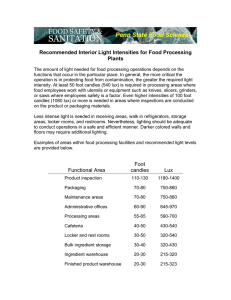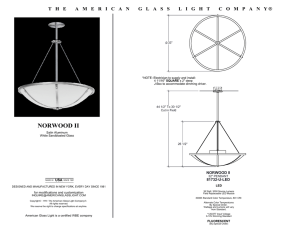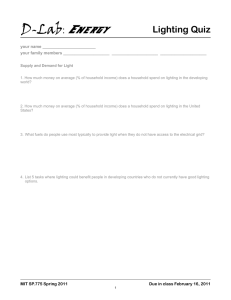Lux, Lumen and Watts, What`s the Difference?
advertisement
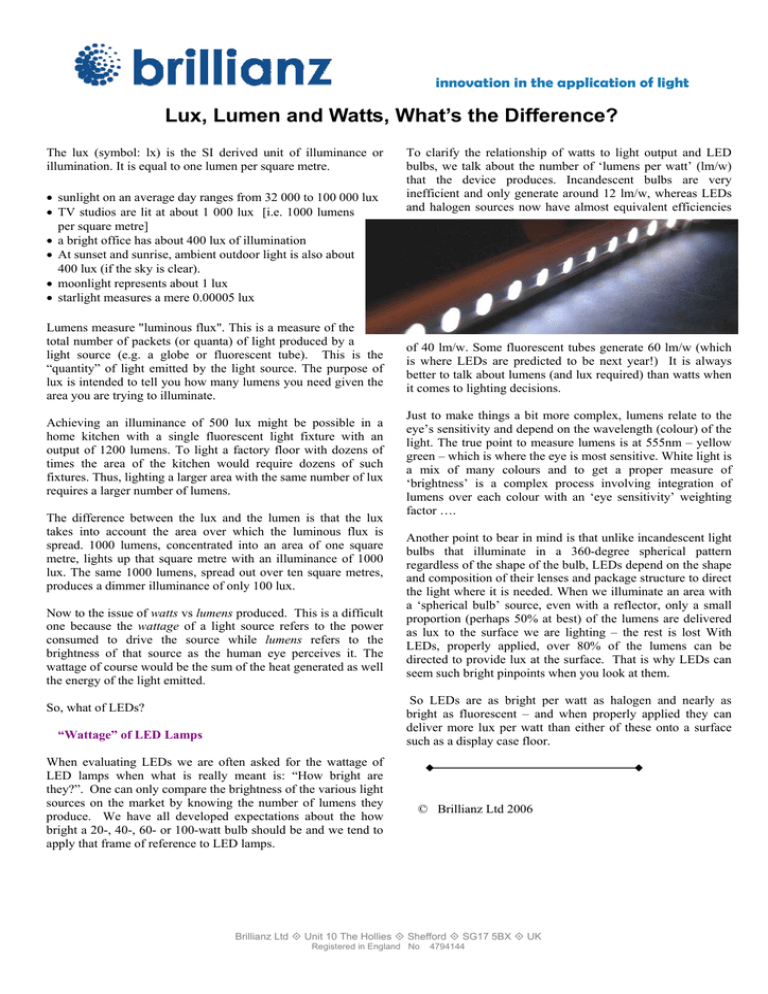
innovation in the application of light Lux, Lumen and Watts, What’s the Difference? The lux (symbol: lx) is the SI derived unit of illuminance or illumination. It is equal to one lumen per square metre. • sunlight on an average day ranges from 32 000 to 100 000 lux • TV studios are lit at about 1 000 lux [i.e. 1000 lumens per square metre] • a bright office has about 400 lux of illumination • At sunset and sunrise, ambient outdoor light is also about 400 lux (if the sky is clear). • moonlight represents about 1 lux • starlight measures a mere 0.00005 lux Lumens measure "luminous flux". This is a measure of the total number of packets (or quanta) of light produced by a light source (e.g. a globe or fluorescent tube). This is the “quantity” of light emitted by the light source. The purpose of lux is intended to tell you how many lumens you need given the area you are trying to illuminate. Achieving an illuminance of 500 lux might be possible in a home kitchen with a single fluorescent light fixture with an output of 1200 lumens. To light a factory floor with dozens of times the area of the kitchen would require dozens of such fixtures. Thus, lighting a larger area with the same number of lux requires a larger number of lumens. The difference between the lux and the lumen is that the lux takes into account the area over which the luminous flux is spread. 1000 lumens, concentrated into an area of one square metre, lights up that square metre with an illuminance of 1000 lux. The same 1000 lumens, spread out over ten square metres, produces a dimmer illuminance of only 100 lux. Now to the issue of watts vs lumens produced. This is a difficult one because the wattage of a light source refers to the power consumed to drive the source while lumens refers to the brightness of that source as the human eye perceives it. The wattage of course would be the sum of the heat generated as well the energy of the light emitted. To clarify the relationship of watts to light output and LED bulbs, we talk about the number of ‘lumens per watt’ (lm/w) that the device produces. Incandescent bulbs are very inefficient and only generate around 12 lm/w, whereas LEDs and halogen sources now have almost equivalent efficiencies of 40 lm/w. Some fluorescent tubes generate 60 lm/w (which is where LEDs are predicted to be next year!) It is always better to talk about lumens (and lux required) than watts when it comes to lighting decisions. Just to make things a bit more complex, lumens relate to the eye’s sensitivity and depend on the wavelength (colour) of the light. The true point to measure lumens is at 555nm – yellow green – which is where the eye is most sensitive. White light is a mix of many colours and to get a proper measure of ‘brightness’ is a complex process involving integration of lumens over each colour with an ‘eye sensitivity’ weighting factor …. Another point to bear in mind is that unlike incandescent light bulbs that illuminate in a 360-degree spherical pattern regardless of the shape of the bulb, LEDs depend on the shape and composition of their lenses and package structure to direct the light where it is needed. When we illuminate an area with a ‘spherical bulb’ source, even with a reflector, only a small proportion (perhaps 50% at best) of the lumens are delivered as lux to the surface we are lighting – the rest is lost With LEDs, properly applied, over 80% of the lumens can be directed to provide lux at the surface. That is why LEDs can seem such bright pinpoints when you look at them. So LEDs are as bright per watt as halogen and nearly as bright as fluorescent – and when properly applied they can deliver more lux per watt than either of these onto a surface such as a display case floor. So, what of LEDs? “Wattage” of LED Lamps When evaluating LEDs we are often asked for the wattage of LED lamps when what is really meant is: “How bright are they?”. One can only compare the brightness of the various light sources on the market by knowing the number of lumens they produce. We have all developed expectations about the how bright a 20-, 40-, 60- or 100-watt bulb should be and we tend to apply that frame of reference to LED lamps. © Brillianz Ltd 2006 Brillianz Ltd Unit 10 The Hollies Shefford SG17 5BX UK Registered in England No 4794144
